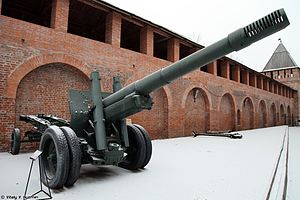152 mm howitzer-gun M1937 (ML-20)
| 152 mm howitzer-gun M1937 (ML-20) | |
|---|---|

ML-20 in museum "The Smolensk Region in the years of Great Patriotic War", Smolensk.
|
|
| Type | Howitzer |
| Place of origin | Soviet Union |
| Production history | |
| Designer | Design bureau of No. 172 Plant, headed by F. F. Petrov |
| Produced | 1937–1947 |
| No. built | 6,884 |
| Specifications | |
| Weight | combat: 7,270 kg (16,027 lb) travel: 7,930 kg (17,482 lb) |
| Length | 8.18 m (26 ft 10 in) (with limber; barrel pulled back) |
| Barrel length | bore: 4.24 m (13 ft 11 in) L/27.9 overall: 4.412 m (10 ft) L/29 (without muzzle brake) |
| Width | 2.35 m (7 ft 9 in) |
| Height | 2.27 m (7 ft 5 in) |
|
|
|
| Caliber | 152.4 mm (6 in) |
| Breech | interrupted screw |
| Recoil | hydropneumatic |
| Carriage | split trail |
| Elevation | -2° to 65° |
| Traverse | 58° |
| Rate of fire | 3-4 rounds per minute |
| Maximum firing range | 17.23 km (10.7 mi) |
The 152 mm howitzer-gun M1937 (ML-20) (Russian: 152-мм гаубица-пушка обр. 1937 г. (МЛ-20)), was a Soviet heavy gun-howitzer. The gun was developed by the design bureau of the plant no 172, headed by F. F. Petrov, as a deep upgrade of the 152-mm gun M1910/34, in turn based on the 152-mm siege gun M1910, a pre-World War I design by Schneider. It was in production from 1937 to 1946. The ML-20 saw action in World War II, mainly as a corps / army level artillery piece of the Soviet Army. Captured guns were employed by Wehrmacht and the Finnish Army. Post World War II, the ML-20 saw combat in numerous conflicts during the mid to late twentieth century.
The ML-20 was officially classified as howitzer-gun, i.e. an artillery system which combines characteristics of a howitzer and (to lesser extent) of a gun and therefore can be used in both roles. This universality was achieved by wide range of elevation angles and by using separate loading with 13 different propellant loads. The gun was fitted with both telescopic sight for direct fire and panoramic sight for an indirect one. For ballistic calculations and meteorological corrections a special mechanical device was developed. The device, called meteoballistic summator, consisted of a specialized slide rule and a pre-calculated table. After World War II similar devices were introduced for other types of guns.
The barrel was either monobloc or built-up. Some sources indicate that a third type - with loose liner - also existed. To soften recoil, a large slotted muzzle brake was fitted. The breechblock was of interrupted screw type, with forced extraction of cartridge during opening. A safety lock prevented opening of the breechblock before the shot; if there was a need to remove a shell, the lock had to be disabled. To assist loading when the barrel was set to high elevation angle, the breach was equipped with cartridge holding mechanism. The gun was fired by pulling a trigger cord.
...
Wikipedia
